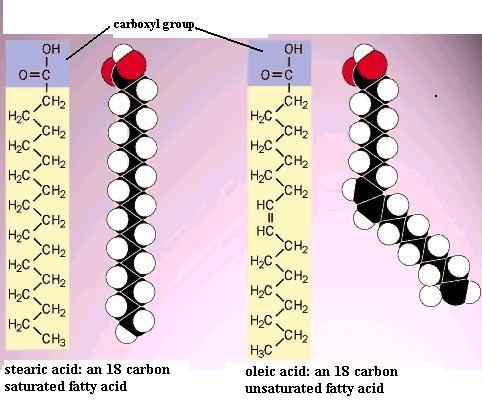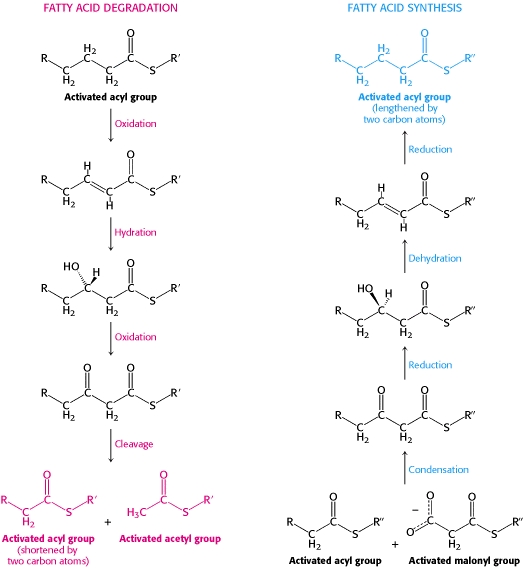Fatty Acid Metabolism |  |
Fatty acids function as fuel molecules, that are stored as triacylglycerols. Fatty acids mobililzed from triacylglycerols are oxidized to meet the energy needs of the cell or organism. During rest or moderate exercise, fatty acids are our primary source of energy. Fatty acids are also building blocks of phospholipids and glycolipids, they can modify proteins, and derviatives of fatty acids serve as hormones and intracellular messengers.
Fatty acid degradation is an oxidative process that converts a fatty acid into a set of activated acetyl units. An activated fatty acid is oxidized to introduce a double bond, followed by hydration of the double bond, and finally another oxidation which turns the hydroxyl group into a ketone. The fatty acid is then cleaved by coenzyme A to yield acetyl CoA and a fatty acid chain minus 2 carbons.
Fatty acid synthesis begins with an activated acyl group and a malonyl unit. The malonyl unit condenses with the acyl unit. The carbonyl of the acyl unit is then reduced and dehydrated introducing a double bond. Finally, the double bond is reduced to get a fatty acid chain plus 2 carbons.

(c) 2007 W.H. Freeman and Company
Glycogen and glucose stores provide enough energy to sustain physiological function for about 24 hours, whereas triacyglycerol stores allow survival for several weeks. The major site of triacyglycerol accumulation is in the cytoplasm of adipose cells. Adipose cells are specialized for the synthesis and storage of triacyglycerols and for their mobilization into fuel molecules.
Dietary Lipids
Most lipids are ingested in the form of triglycerides and must be degraded to faty acids for absorption acorss the intestinal epithelium. Intestinal enzymes called lipases, secreted by the pancreas degrade triglycerides to free fatty acids and monoglyceride. Triglycerides in the intestinal lumen are incorporated into micelles composed of bile salts, which are synthesized from cholesterol in the liver and secreted from the gall bladder. The final digestion products (free fatty acids and monoglyceride) are transported in micelles to the intestinal epithelium where they are transported across the plasma membrane.
Chylomicrons
Once transported into the intestinal mucosal cell, triglycerides are resynthesized from fatty acids and monoacylglycerols. The triacylglycerols are then packaged into lipoprotein transport particles called chylomicrons. Chylomicrons are mainly triacylglcerols, with apolipoprotein B-48 as the main protein component. (Note: chylomicrons also transport fat soluble vitamins and cholesterol. Chylomicrons are released from the intestinal cell into lymphatic vessels which drain into the blood stream. Chylomicrons bind to membrane bound lipases, primarily at adipose and muscle tissue, where triacylglycerols are again degraded into free fatty acids and monoacylglycerol for transport into the tissue. Once inside the adipose or muscle tissue, triacylglycerols are agains resynthesized and stored.
Utilization of Fatty Acids as Fuels
Before fats can be used as fuels, they must be hydrolyzed to yield isolated fatty acids. When fatty acids are needed for energy, glucagon and/or epinephrine will be present. These hormones signal a cAMP cascade in adipose tissue which stimulates protein kinase A. Protein kinase A in adipose tissue will phosphorylae perilipin A and hormone sensitive lipase. Perilipin A restructures the fat droplet to make the triacyglycerols more accesible to the hormone sensitive lipase. Once phosphorylated, the hormone sensitive lipase hydrolyzes triacyglycerols to free fatty acids. The free fatty acids are not soluble in plasma, so once released into the bloodstream, serum albumin serves as a carrier.
Glycerol formed from lipolysis is absorbed by the liver and phosphorylated by glycerol kinase. The product, glycerol-3-phosphate is then oxidized by NAD+ to dihydroxyacetone phosphate, which is isomerized to glyceraldehyde-3-phosphate. This molecule is used in both the glycolytic and gluconeogenic pathway.
Activation of Fatty Acids for Oxidation
ATP drives the formation of a thioester linkage between the carboxyl group of a fatty acids and the sulfhydryl group of CoA. This activation takes place on the outer mitochondrial membrane, and is catalyzed by acyl CoA synthetase. In this reaction, the released PPi is rapidly hydrolyzed to Pi + Pi to drive the reaction forward.
Fatty Acid Transporter
Fatty acids are activated on the outer mitochondrial membrane, but they are oxidized in the mitochondrial matrix. A special transport mechanism is used to carry activated long chain fatty acids across the inner mitochondrial membrane. The acyl group is transferred from the sulfur atom of CoA to carnitine. This reaction is catalyzed by carnitine acyl transferase I, which is on the outer mitochondrial membrane. Acyl carnitine is then shuttled across the inner mitochondrial membrane by translocase. On the matrix side of the membrane, the acyl group is transferred back to CoA, this reaction is catalyzed by carnitine acyltransferase II.

(c) 2007 W.H. Freeman and Company
Fatty Acid Oxidation
Fatty acid oxidation consists of four recurring reactions:
(1) Acyl CoA is oxidized by acyl CoA dehydrogenase to yield and double bond and reduce FAD to FADH2. Eventually, these electrons are transferred to ubiquinone, which delivers the electrons to Complex III.
(2) The double bond is hydrated by enoyl CoA hydratase, forming a hydroxyl group.
(3) The hydroxyl group is oxidized to an keto group by L-3-hydroxyacyl CoA dehydrogenase, reducing NAD+ to NADH.
(4) Beta-ketothiolase then catalyzes cleavage by another CoA.